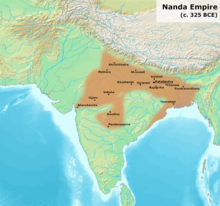
Back Chandragupta Maurya ALS تشاندراغبت موريا Arabic تشاندراجبت موريا ARZ চন্দ্ৰগুপ্ত মৌৰ্য Assamese Chandragupta Maurya AST चन्द्रगुप्त मौर्य AWA چاندراقوپتا مائوریا AZB Чандрагупта Маурья Bashkir Чандрагупта Маур’я Byelorussian Чандрагупта Bulgarian
| Chandragupta Maurya | |
|---|---|
 Chandragupta Maurya in a stamp issued by the Indian Government in 2001 | |
| 1st Mauryan Emperor | |
| Reign | c. 320 – c. 297 BCE[1][2] |
| Coronation | c. 320 BCE |
| Predecessor | Position established |
| Successor | Bindusara[3] |
| Born | possibly c. 350–340 BCE Pataliputra, Magadha, Nanda Empire (near present-day Patna) (according to Buddhist legend) |
| Died | after c. 297 BCE Kalbappu (Chandragiri) (present-day Karnataka, India) (According to Jain tradition) |
| Spouse | Durdhara A Seleucid princess (name unknown) |
| Issue | Bindusara |
| Dynasty | Maurya |
| Maurya Empire (322–180 BCE) | ||||||||||||||||||||
|---|---|---|---|---|---|---|---|---|---|---|---|---|---|---|---|---|---|---|---|---|
|
||||||||||||||||||||



Chandragupta Maurya[d] (reigned c. 320 BCE[e] – c. 298 BCE)[f] was the founder of the Maurya Empire, based in Magadha (present-day Bihar).
His rise to power began in the period of unrest and local warfare that arose after Alexander the Great's Indian campaign and early death in 323 BCE, although the exact chronology and sequence of events remains subject to debate among historians. He started a war against the unpopular Nanda dynasty in Magadha on the Ganges Valley,[6] defeated them and established his own dynasty. In addition, he raised an army to resist the Greeks,[7][8][9][g] defeated them, and took control of the eastern Indus Valley.[10] His conquest of Magadha is generally dated to ca. 322-319 BCE,[11][12] and his expansion to Punjab subsequently at ca. 317-312 BCE,[h] but some scholars have speculated that he might have initially consolidated his power base in Punjab, before conquering Magadha;[h] an alternative chronology places these events all in the period ca. 311-305 BCE.[13][e] According to Buddhist and Jain legends, Chandragupta was assisted by his mentor Chanakya, who later became his minister. He expanded his reach subsequently into parts of the western Indus Valley[i] and possibly[14] eastern Afghanistan[b] through a dynastic marriage alliance with Seleucus I Nicator ca. 305-303 BCE.[10] His empire also included Gujarat[j] and a geographically extensive network of cities and trade-routes.[a][b]
There are no historical facts about Chandragupta's origins and early life, only legends, while the narrative of his reign is mainly deduced from a few fragments in Greek and Roman sources, and a few Indian religious texts, all written centuries after his death. The prevailing levels of technology and infrastructure limited the extent of Chandragupta's rule,[k] and the administration was decentralised, with provinces and local governments,[15][l] and large autonomous regions within its limits.[m] Chandragupta's reign, and the Maurya Empire, which reached its peak under his grandson Ashoka the Great,[n] began an era of economic prosperity, reforms, infrastructure expansions. Buddhism, Jainism and Ājīvika prevailed over the non-Maghadian Vedic and Brahmanistic traditions,[16] initiating, under Ashoka, the expansion of Buddhism, and the synthesis of Brahmanic and non-Brahmanic religious traditions which converged in Hinduism. His legend still inspires visions of an undivided Indian nation.
- ^ a b Chandragupta Maurya, Emperor of India Archived 10 March 2018 at the Wayback Machine, Encyclopædia Britannica
- ^ Upinder Singh 2016, p. 330.
- ^ Upinder Singh 2016, p. 331.
- ^ Kulke & Rothermund 2004, p. 59-65.
- ^ Boesche 2003, p. 7-18.
- ^ Mookerji 1988, p. 6.
- ^ Mookerji 1988, p. 6-8, 22, 31-33.
- ^ Hemacandra 1998, pp. 175–188.
- ^ Raychaudhuri 1967, pp. 144–145.
- ^ a b Danielou 2003, p. 85-86.
- ^ Roy 2012, pp. 27, 61–62.
- ^ Jansari 2023, p. 18.
- ^ Jansari 2023, p. 31.
- ^ Coningham & Young 2015, p. 452-453.
- ^ Mookerji 1988, pp. 47, 52–53.
- ^ Bronkhorst 2007.
Cite error: There are <ref group=lower-alpha> tags or {{efn}} templates on this page, but the references will not show without a {{reflist|group=lower-alpha}} template or {{notelist}} template (see the help page).

